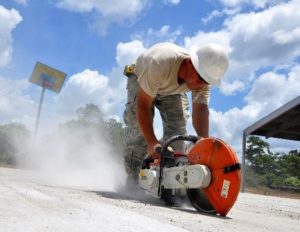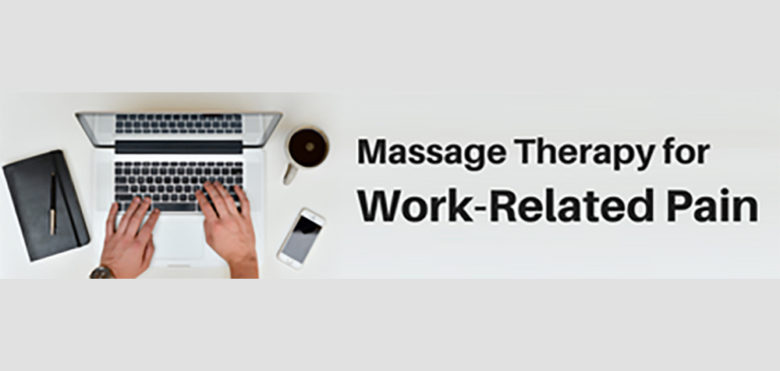Don’t Work Through The Pain
We spend a lot of time at work, and sometimes work can lead to injuries that negatively impact every element of our lives.
 It can be our work tasks, or the way we do them, that have a lasting negative impact on our bodies. According to the Workplace Safety and Insurance Board, musculoskeletal injuries are the most common type of workplace injury in Ontario [1]. Don’t let your work become a pain! There are things you can do to prevent workplace injuries, and if workplace injuries do happen, there are things you can do to treat them.
It can be our work tasks, or the way we do them, that have a lasting negative impact on our bodies. According to the Workplace Safety and Insurance Board, musculoskeletal injuries are the most common type of workplace injury in Ontario [1]. Don’t let your work become a pain! There are things you can do to prevent workplace injuries, and if workplace injuries do happen, there are things you can do to treat them.
Common Injuries at Work
Doing repetitive tasks carries a particular risk of work-related injury. Carpal tunnel syndrome causes pain in the median nerve, which includes the palm, thumb, middle and index fingers. Often it can be caused by repetitive motions that require flexing your wrist or elevating your hand, like driving or holding a telephone for long periods. Another common workplace injury that can come from repetitive movement or occasionally awkward posture is neck strain. Neck pain is associated with several workplace risk factors, which can include increased workplace demands and stress.
Low back pain is extremely common, with 80 percent of the population experiencing an episode of low back pain at some point in their lives [2]. It’s also a very common reason to have to stay home from work. Second only to minor illnesses like colds and flus, back pain is a primary reason for missing work for Canadian workers [3]. Back problems can also be related to repetitive strain injuries, among many other factors. If you’re experiencing any of these injuries, massage therapy can help!
Massage Therapy Can Help
 Massage therapy is part of an effective conservative care approach for many work-related injuries. Massage therapy can help treat carpal tunnel syndrome, helping to increase strength, improve function, and reduce pain [4,5]. Massage therapy is also an effective treatment for neck pain, and it will commonly reduce pain and improve neck function [6,7]. A wide range of musculoskeletal complaints can be work related, and regular on-site massage for office workers has been found to be extremely effective for decreasing the duration of musculoskeletal aches, pains, and discomfort at work [8,9].
Massage therapy is part of an effective conservative care approach for many work-related injuries. Massage therapy can help treat carpal tunnel syndrome, helping to increase strength, improve function, and reduce pain [4,5]. Massage therapy is also an effective treatment for neck pain, and it will commonly reduce pain and improve neck function [6,7]. A wide range of musculoskeletal complaints can be work related, and regular on-site massage for office workers has been found to be extremely effective for decreasing the duration of musculoskeletal aches, pains, and discomfort at work [8,9].
Of all musculoskeletal pain, back pain is extremely common [10], and people frequently seek massage therapy to help them with their back problems. Regular massage therapy care can reduce pain and improve function in patients with low back pain [11].
You don’t want work to become a pain in the neck – or in any other part of your body. Ask your RMT how they can help.
References
[1] Workplace Safety and Insurance Board. (2016). By the Numbers: 2016 WSIB Statistical Report. Retrieved from: www.wsibstatistics.ca [link]
[2] Rubin Dl. (2007). Epidemiology and Risk Factors for Spine Pain. Neurol Clin, 25(2):353-71. [link]
[3] Stewart, Nicole. (2013). Missing In Action: Absenteeism Trends in Canadian Organizations. The Conference Board of Canada: Ottawa. [link]
[4] Moraska, A., Chandler, C., Edmiston-Schaetzel, A., Franklin, G., Calenda, E., Enebo, B. (2008). Comparison of a targeted and general massage protocol on strength, function, and symptoms associated with carpal tunnel syndrome: a randomized pilot study. J Altern Complement Med, 14(3):259-267. [link]
[5] Wipperman, J., Goerl, K. (2016). Carpal tunnel syndrome: diagnosis and management. Am Fam Physician, 94(12):993-999. [link]
[6] Kong, L.J., Zhan, H.S., Cheng, Y.W., Yuan, W.A., Chen, B., Fang, M. (2013). Massage therapy for neck and shoulder pain: a systematic review and meta-analysis. Evid Based Complement Alternat Med., 2013:613279. [link]
[7] Sherman, K.J., Cook, A.J., Wellman, R.D., Hawkes, R.J., Kahn, J.R., et al. (2014). Five-week outcomes from a dosing trial of therapeutic massage for chronic neck pain. Ann Fam Med, 12(2):112-120. [link]
[8] Siško, P.K., Videmšek, M., Karpljuk, D. (2011). The effect of a corporate chair massage program on musculoskeletal discomfort and joint range of motion in office workers. J Altern Complement Med, 17(7):617-622. [link]
[9] Yang, H., Hitchcock, E., Haldeman, S., Swanson, N., Lu, M.L., et al. (2016). Work related psychosocial and organizational factors for neck pain in workers in the United States. Am J Ind Med, 59(7):549–560. [link]
[10] Freburger, J.K., Holmes, G.M., Agans, R.P., Jackman, A.M., Darter, J.D., et al. (2009). The Rising Prevalence of Chronic Low Back Pain. Arch Intern Med, 169(3):251–258. [link]
[11] Cherkin, D.C., Sherman, K.J., Kahn, J., Wellman, R., Cook, A.J., Johnson, E., et al. (2011). A comparison of the effects of 2 types of massage and usual care on chronic low back pain: a randomized, controlled trial. Ann Intern Med, 155(1):1-9. [link]


Leave a Comment